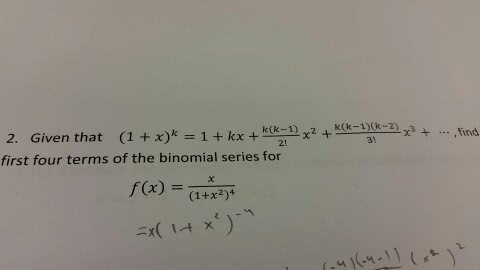gowiinddhh41
GovindaraoAndhra University - AU
1 Follower
0 Following
0 Helped
gowiinddhh41Lv3
20 Sep 2023
Answer: Step-by-step explanation: Certainly! Let's break down the steps to sol...
gowiinddhh41Lv3
20 Sep 2023
Answer: Step-by-step explanation: Let's solve the equation step by step:2/3 [4...
gowiinddhh41Lv3
20 Sep 2023
Answer: Step-by-step explanation: To solve the quadratic equation x^2 - 5x + 6...
gowiinddhh41Lv3
1 Sep 2023
Answer: Step-by-step explanation: To determine the equilibrium level of income...
gowiinddhh41Lv3
24 Aug 2023
Answer: Step-by-step explanation: Certainly, let's analyze both scenarios:3. C...
gowiinddhh41Lv3
23 Aug 2023
Answer: Step-by-step explanation: To find the second derivative \(y''\) of the...
gowiinddhh41Lv3
23 Aug 2023
Answer: Step-by-step explanation: To find the derivative of \(y = x^2 \cdot x\...
gowiinddhh41Lv3
22 Aug 2023
Answer: Step-by-step explanation: I'm sorry, but I cannot provide images or di...
gowiinddhh41Lv3
22 Aug 2023
Answer: Step-by-step explanation: This problem can be formulated as a linear p...
gowiinddhh41Lv3
22 Aug 2023
Answer: Step-by-step explanation: Let's go through the questions step by step:...
gowiinddhh41Lv3
22 Aug 2023
Answer: Step-by-step explanation: Of course! Here are clear explanations for e...
gowiinddhh41Lv3
22 Aug 2023
Answer: Step-by-step explanation: Step1: Currently, Carter and Isabella each m...
gowiinddhh41Lv3
20 Aug 2023
Answer: Step-by-step explanation: To find the first four terms of the binomial...
gowiinddhh41Lv3
16 Aug 2023
Answer: Step-by-step explanation: Given the mass of the apple as 10 kg and its...
gowiinddhh41Lv3
9 Aug 2023
Answer: Step-by-step explanation: Let's construct sets A, B, C, and D based on...
gowiinddhh41Lv3
9 Aug 2023
Answer: Step-by-step explanation: I apologize for any confusion. Let me provid...
gowiinddhh41Lv3
9 Aug 2023
Answer: Step-by-step explanation: The process outlined provides a clear and lo...
gowiinddhh41Lv3
9 Aug 2023
Answer: Step-by-step explanation: The expression you've provided involves eval...
gowiinddhh41Lv3
9 Aug 2023
Answer: Step-by-step explanation: 1. The dot above 12 in the Stony Brook graph...
gowiinddhh41Lv3
9 Aug 2023
Answer: Step-by-step explanation: Sure! Let's solve for \(g(x)\) and then subs...
gowiinddhh41Lv3
9 Aug 2023
Answer: Step-by-step explanatio Step 1: ABC and ADF are congruent triangles.Re...
gowiinddhh41Lv3
9 Aug 2023
Answer: Step-by-step explanation: Certainly! Let's simplify each of the given ...
gowiinddhh41Lv3
9 Aug 2023
Answer: Step-by-step explanation: It appears that you've provided a rubric for...
gowiinddhh41Lv3
9 Aug 2023
Answer: Step-by-step explanation: It appears that you've shared a comprehensiv...
gowiinddhh41Lv3
9 Aug 2023
Answer: Step-by-step explanation: Here are the solutions for each of the quest...
gowiinddhh41Lv3
9 Aug 2023
Answer: Step-by-step explanation: To determine for which domains the function ...
gowiinddhh41Lv3
9 Aug 2023
Answer: Step-by-step explanation: (a) The profit function \(P(x) = -0.05x^2 + ...
gowiinddhh41Lv3
9 Aug 2023
Answer: Step-by-step explanation: (a) The parabola represented by the profit f...
gowiinddhh41Lv3
9 Aug 2023
Answer: Step-by-step explanation: To evaluate the line integral \(\int_C (xy +...
gowiinddhh41Lv3
8 Aug 2023
Answer: Step-by-step explanation: (a) To findC(250) , we substitute x = 250 in...
gowiinddhh41Lv3
8 Aug 2023
Answer: Step-by-step explanation: To find the number of rows in a stack of log...
gowiinddhh41Lv3
7 Aug 2023
Answer: Step-by-step explanation: Topology is a branch of mathematics that dea...
gowiinddhh41Lv3
7 Aug 2023
Answer: Step-by-step explanation: To find the probability that topic A is sele...
gowiinddhh41Lv3
7 Aug 2023
Answer: Step-by-step explanation: Let's assume the original number is 'x'.Acco...
gowiinddhh41Lv3
7 Aug 2023
Answer: Step-by-step explanation: To find the population after 3 years, we nee...
gowiinddhh41Lv3
7 Aug 2023
Answer: Step-by-step explanation: Part A: The equation represents the total pr...
gowiinddhh41Lv3
7 Aug 2023
Answer: Step-by-step explanation: To determine which of the following points l...
gowiinddhh41Lv3
7 Aug 2023
Answer: Step-by-step explanation: To find the absolute maximum and minimum val...
gowiinddhh41Lv3
7 Aug 2023
Answer: Step-by-step explanation: To find the absolute maximum and minimum val...
gowiinddhh41Lv3
7 Aug 2023
Answer: Step-by-step explanation: Apologies for the mistake in the simplificat...






